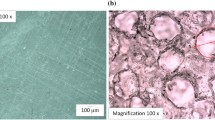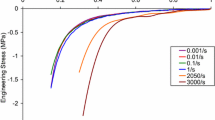Abstract
One-dimensional interaction between a planar shock wave and a rubber or low-porosity foam is investigated experimentally and numerically. The considered polyurethane foam is of high density (ρ c=290 kg/m3) and lowporosity (ϕ=0.76), and this corresponds to an intermediate condition between rubber and high-porosity foam. Stress-strain relations for the low-porosity foam are investigated by machine tests, which show larger deformation against compressive force and higher non-linearity in stress-strain curve as compared with rubber. Also the low-porosity foam shows a hysteresis cycle. Experiments on shock wave-foam interactions are conducted by using a shock tube. Experimental time history of the surface stress of the foam at the end of the shock tube does not show shock type stress increase, but continuous excessive stress rise can be seen, and then dumping vibration approaching to gas dynamic pressure of the reflected shock wave is followed, and the highest stress amounts about 3∼4 times of the pressure after the reflected gas dynamic shock wave. Interactive motions of gas and the low-porosity foam are analyzed using the Lagrangean coordinates system. An elastic model for a low-porosity foam is assumed to be a single elastic material with the measured stress-strain relation. Results of numerical simulations are compared with the shock tube experiments, which show essentially same stress variations with experimental results.
Similar content being viewed by others
References
Baer MR (1992) A numerical study of shock wave reflections on low density foam. Shock Waves 2:121–124
Ben-Dor G, Mazor G, Igra O, Sorek S, Onodera H (1994) Shock wave interaction with cellular materials. Part II: open cell foams; experimental and numerical results. Shock Waves 3:167–179
Gibson LJ, Ashby MF (1988) Cellular solids:structure and properties, 1st edn., Pergamon Press
Mazor G, Igra O, Ben-Dor G, Mond M, Reichenbach M (1992) Headon collision of normal shock waves with a rubber-supported wall. Phil Trans R Soc Lond A 338:237–269
Mazor G, Ben-Dor G, Igra O, Sorek S (1994) Shock wave interaction with cellular materials. Part I: open cell foams; experimental and numerical results. Shock Waves 3:159–165
Skews BW (1991) The reflected pressure field in the interaction of weak shock waves with a compressible foam. Shock Waves 3:205–211
Skews BW, Atkins MD, Seitz MW (1993) The impact of a shock wave on porous compressible foams. J Fluid Mech 253:245–265
Treloar LRG (1975) The physics of rubber elasticity, 3rd edn., Clarendon Press
Author information
Authors and Affiliations
Rights and permissions
About this article
Cite this article
Yasuhara, M., Kitagawa, K., Sakashita, S. et al. One-dimensional shock wave interaction with rubber and low-porosity foam. Shock Waves 5, 25–32 (1995). https://doi.org/10.1007/BF02425033
Received:
Accepted:
Issue Date:
DOI: https://doi.org/10.1007/BF02425033




